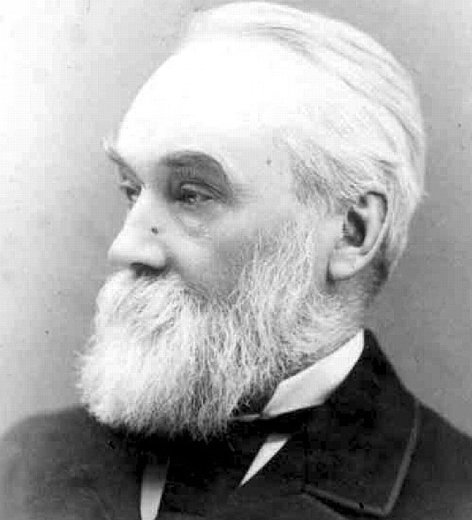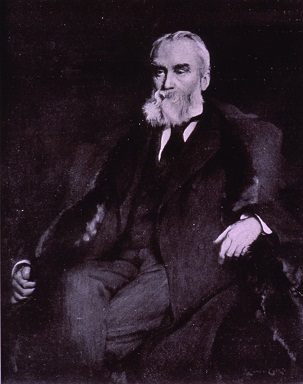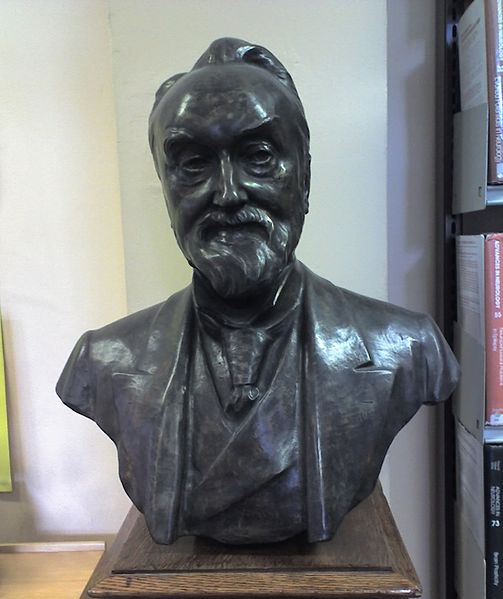<Back to Index>
- Neurologist John Hughlings Jackson, 1835
- Painter William Dobson, 1610
- Duke of Viseu Henry the Navigator, 1394
PAGE SPONSOR


John Hughlings Jackson, FRS (4 April 1835 - 7 October 1911), was an English neurologist.
He was born at Providence Green, Green Hammerton, near Harrogate, Yorkshire, the youngest son of Samuel Jackson, a yeoman who owned and farmed his land, and the former Sarah Hughlings, the daughter of a Welsh revenue collector. His mother died just over a year after giving birth to him. He had three brothers and a sister; his brothers emigrated to New Zealand and his sister married a physician. He was educated at Tadcaster, Yorkshire, and Nailsworth, Gloucestershire, before attending the York Medical and Surgical School. After qualifying at St Barts in 1856 he became house physician to the York Dispensary.
In 1859 he returned to London to work at the Metropolitan Free Hospital and the London Hospital. In 1862 he was appointed Assistant Physician, later (1869) full Physician at the National Hospital for Paralysis and Epilepsy located in Queen Square, London (now the National Hospital for Neurology and Neurosurgery) as well as Physician (1874) at the London Hospital. During this period he established his reputation as a neurologist. He was elected a Fellow of the Royal Society in 1878.
Jackson died in London on 7 October 1911 and was buried in Highgate cemetery. Jackson
was an innovative thinker and a prolific and lucid, if sometimes
repetitive, writer. Though his range of interests was wide, he is best
remembered for his seminal contributions to the diagnosis and
understanding of epilepsy in all its forms and complexities. His name is attached eponymously to the characteristic "march" of symptoms in focal motor seizures and to the so-called "dreamy state" of psychomotor seizures of temporal lobe origin.
His papers on the latter variety of epilepsy have seldom been bettered
in their descriptive clinical detail or in their analysis of the
relationship of psychomotor epilepsy to various patterns of pathological automatism and other mental and behavioural disorders. In
his youth Jackson had been interested in conceptual issues and it is
believed that in 1859 he contemplated the idea of abandoning medicine
for philosophy. Thus,
an important part of his work concerned the evolutionary organization
of the nervous system for which he proposed three levels: a lower, a
middle, and a higher. At the lowest level, movements were to be
represented in their least complex form; such centres lie in the
medulla and spinal cord. The middle level consists of the so-called
motor area of the cortex, and the highest motor levels are found in the
prefrontal area. The
higher centres inhibited the lower ones and hence lesions thereat
caused ‘negative’ symptoms (due to an absence of function). ‘Positive’
symptoms were caused by the functional release of the lower centres.
This process Jackson called ‘dissolution’, a term he borrowed from
Herbert Spencer. The ‘positive - negative’ distinction he took from Sir John Reynolds. Continental
psychiatrists and psychologists (e.g. Ribot, Janet, Freud, Ey) have
been more influenced by Jackson’s theoretical ideas than their British
counterparts. During
the 1980s, the ‘positive - negative’ distinction was temporarily
fashionable in relation to the symptoms of schizophrenia. He was one of only a few physicians to have delivered the Goulstonian (1869), Croonian (1884) and Lumleian (1890) lectures to the Royal College of Physicians He also delivered the 1872 Hunterian Oration to the Hunterian Society. Jackson
could not use modern sophisticated neuro - investigative technology (it
had not been invented), but had to rely upon his own powers of clinical
observation and deductive logic. Some of his eminent successors in the
field of British neurology have been critical of many of his theories
and concepts; but as Sir Francis Walshe remarked
of his work in 1943, " ... when all that is obsolete or irrelevant is
discarded there remains a rich treasure of physiological insight we
cannot afford to ignore." In Otfrid Foerster's
research on the motor cortex, he cites exclusively Hughlings Jackson
for the initial discovery (although without evidence) of the brain as
the spring of neurological motor signaling.
Together with his friends Sir
David Ferrier and Sir James Crichton - Browne, two eminent neuropsychiatrists of his time, Jackson was one of the founders of the important Brain journal,
which was dedicated to the interaction between experimental and
clinical neurology (still being published today). Its inaugural issue
came to light in 1878. In 1892, Jackson was one of the founding members of the National Society for the Employment of Epileptics (now the National Society for Epilepsy), along with Sir William Gowers and Sir David Ferrier. Oliver Sacks has repeatedly cited Jackson as an inspiration in his neurologic work.
